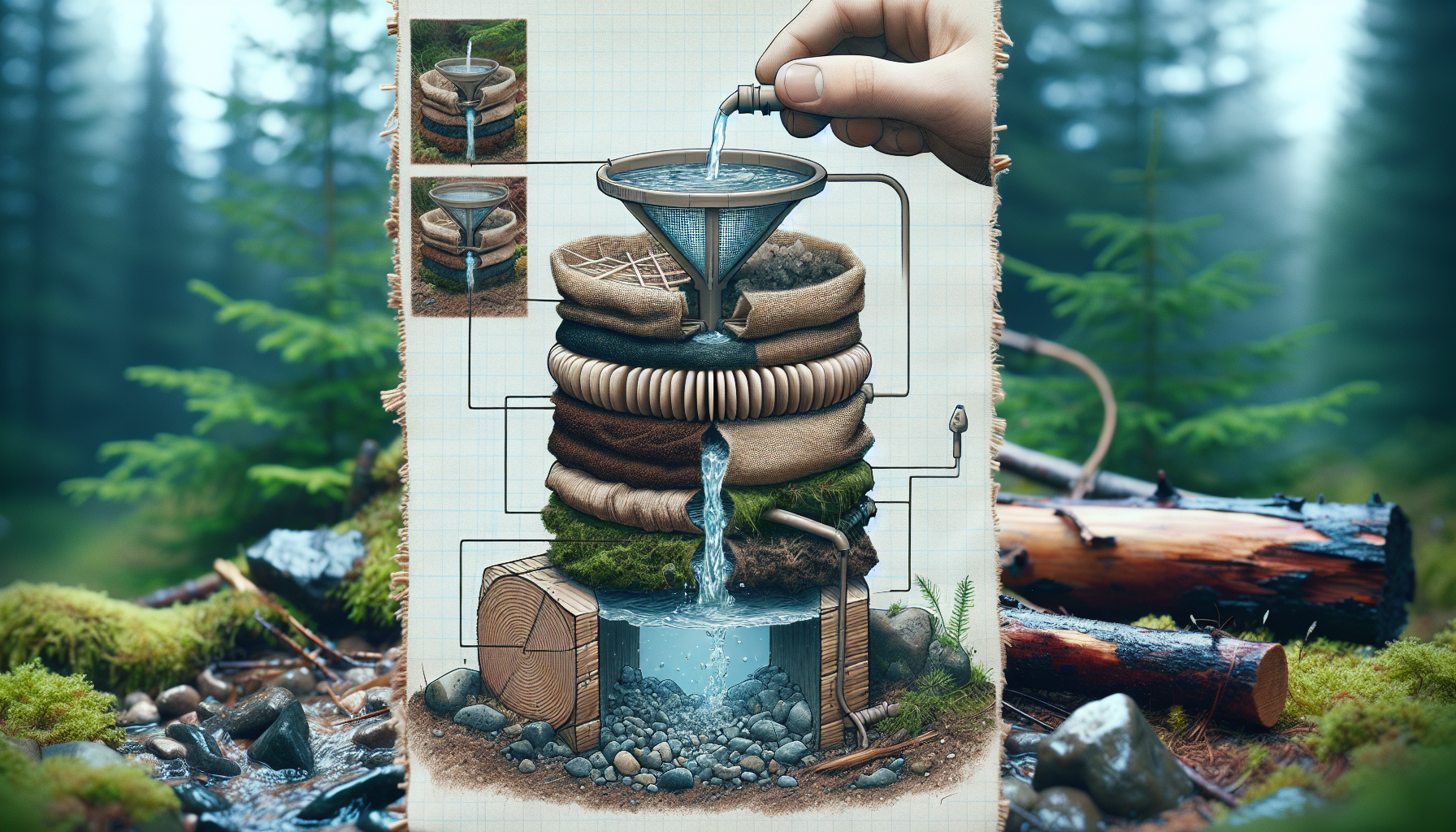
In the quest for enhancing your outdoor survival capabilities, the burning question arises: how can you effectively improve these indispensable skills? In this article, we will explore various strategies and techniques that can be employed to enhance your competence in navigating the wilderness, overcoming unforeseen challenges, and ensuring your safety in extreme outdoor scenarios. Whether you are an experienced adventurer seeking to refine your existing skills or a novice embarking on your first outdoor expedition, this article aims to equip you with the necessary knowledge and insights to bolster your resilience and confidence in the great outdoors.
Finding and Purifying Water
When you find yourself in a survival situation in the great outdoors, one of your most immediate needs is finding a source of clean drinking water. Identifying water sources becomes crucial, and you need to be able to distinguish between safe and contaminated water. Look for sources such as rivers, streams, and lakes, as they are usually the most reliable sources of water in the wilderness.
However, it’s important to note that not all water sources are safe to drink. Water from natural sources may be contaminated with bacteria, viruses, and parasites that can cause severe illness. To purify water and make it safe to drink, you have several different methods at your disposal.
Boiling water is perhaps the most effective way to purify it. By bringing the water to a rolling boil for at least one minute (or three minutes at higher altitudes), you can kill most microorganisms that may be present. Another popular method is using water purification tablets or drops, which typically contain chemicals such as chlorine or iodine that kill harmful organisms.
If you don’t have access to these methods, you can also create a makeshift water filter. This can be done by finding a container or constructing one from natural materials, such as a hollowed-out log or bamboo stalk. Fill the container with layers of various filtering materials, such as sand, charcoal, and cloth, and let gravity do the work as the water passes through the layers, removing impurities.
Building Shelter
Building a shelter is crucial for your survival in the wilderness, as it provides protection from the elements and helps maintain body temperature. When choosing a location for your shelter, consider factors such as protection from wind, proximity to water, and availability of natural resources. Look for areas with natural materials, such as fallen branches or rocks, that can be used for your shelter.
When it comes to materials for building a shelter, you have a variety of options. If you’re in a forested area, you can gather branches, leaves, and bark to construct a lean-to shelter. This involves leaning branches against a sturdy support, such as a fallen tree or large rock, and covering them with leaves or bark for insulation.
Another option is to build a debris hut, which involves creating a framework of branches and covering it with layers of leaves, grass, or other natural materials. This type of shelter provides excellent insulation and protection from the elements.
If you have a tarp or a poncho with you, you can easily create a tarp shelter by suspending it between trees and securing it with ropes or branches. This type of shelter is quick to set up and provides good protection from rain and wind.
To further insulate your shelter and retain warmth, gather additional materials such as leaves, ferns, or pine needles to create a thick layer on the floor of your shelter. This added insulation will help to keep you warm during cold nights.
Navigating and Orienteering
Navigating and orienteering skills are essential for finding your way in the wilderness and ensuring your safety. Understanding maps and compasses is a fundamental part of navigation. Familiarize yourself with topographic maps and learn how to read contour lines to identify features such as valleys, ridges, and streams. Compasses help you determine your direction of travel and can be used in conjunction with a map to plot your course.
In addition to using traditional tools like maps and compasses, you can also utilize natural navigation methods. The stars, the sun, and landmarks can all provide valuable information about your location and help you navigate. By learning to identify and navigate using celestial bodies or natural features, you can find your way even without relying solely on man-made tools.
Finding and following trails is another important aspect of wilderness navigation. Look for signs of human activity, such as footprints, disturbed vegetation, or marked trees. Trails often lead to sources of water, human settlements, or other points of interest that can aid in your survival.
Basic orienteering techniques, such as pacing and handrail navigation, can help you stay on track. Pacing involves counting your steps over a known distance to estimate the distance you have traveled. Handrail navigation involves following a prominent natural or man-made feature, such as a river or road, to maintain your intended direction.
Fire Starting Techniques
Fire is not only useful for cooking food and providing warmth, but it can also serve as a signal for rescue. In a survival situation, knowing how to start a fire is an essential skill. Collecting tinder, kindling, and fuel is the first step in the process.
Tinder refers to easily ignitable materials, such as dry leaves, grass, or fine wood shavings. Kindling consists of small sticks and twigs that catch fire quickly and sustain the flame. Fuel, on the other hand, refers to larger pieces of wood that will provide a long-lasting and steady source of heat.
There are several methods for starting a fire, each with its own advantages and disadvantages. Friction-based methods, such as the bow drill or hand drill, involve using a spindle and a fireboard to generate heat through friction. Flint and steel is another reliable method, where a hard flint stone is struck against a piece of steel to create sparks that ignite the tinder. Matches are a more convenient option if you have them available.
Once you have started a fire, it’s important to build a fire pit and fire lay to contain and control the flames. Clear an area of any flammable materials and create a small depression in the ground for the fire. Construct a fire lay by arranging your kindling and fuel in a teepee or log cabin structure around the tinder. This allows air to circulate and helps the fire burn more efficiently.
Safety is paramount when maintaining a fire in the wilderness. Always ensure your fire is attended and properly extinguished before leaving it. Use water, sand, or dirt to fully douse the flames, and scatter the ashes to prevent any embers from reigniting.
Foraging for Food
When food is scarce, knowing how to identify edible plants and mushrooms can mean the difference between starvation and survival. However, it’s important to note that foraging for food carries risks, as there are also poisonous plants and fungi in the wilderness.
Educate yourself about the edible plants and mushrooms that are native to your area before venturing into the wilderness. Look for field guides or consult with experts to learn how to identify these potentially life-saving food sources. Pay attention to features such as leaf shape, color, and texture, as well as any distinct smells or tastes.
In addition to foraging for plants, it’s also crucial to know how to locate and catch small game. Look for signs of animal activity, such as tracks, droppings, or feeding areas. Construct simple traps and snares using natural materials to maximize your chances of catching small game for sustenance. However, it’s important to check local hunting and trapping regulations and obtain the necessary licenses if available.
As with any activity in the wilderness, safety should always be a top priority. Before consuming any wild food, make sure you have positively identified it as safe. Start with small quantities to test for any adverse reactions, and be aware of potential allergens. It’s also a good idea to familiarize yourself with any potential poisonous plants in the area to avoid accidental ingestion.
First Aid and Wilderness Medicine
In a survival situation, being knowledgeable in basic first aid techniques can be a matter of life and death. Carrying a well-equipped first aid kit is essential, as it will contain the necessary supplies to treat injuries and manage medical emergencies. Make sure your kit includes items such as bandages, antiseptic solutions, adhesive tape, and scissors.
Having a strong understanding of basic wilderness first aid techniques is crucial. This includes knowing how to assess a victim’s vital signs, administer CPR, and manage bleeding control. Additionally, learning how to treat common injuries such as cuts, burns, and sprains is necessary for providing immediate care in the wilderness.
Recognizing and treating heat and cold-related illnesses is also vital for wilderness survival. Heat exhaustion, heat stroke, hypothermia, and frostbite are all potential risks when exposed to extreme temperatures. Know the signs and symptoms of these conditions and be prepared to provide appropriate treatment, such as cooling the body in cases of heat exhaustion or rewarming cold exposed areas in cases of hypothermia.
Remember, wilderness first aid should be seen as initial care until professional medical help can be sought. Obtain formal first aid and wilderness medicine training whenever possible to enhance your skills and confidence in emergency situations.
Food and Water Procurement
Procuring food and water in the wilderness may be necessary for long-term survival. There are various methods you can employ to secure these essential resources.
Fishing and trapping are effective techniques for procuring food in water-rich areas. Learn how to fashion basic fishing tools such as hooks, lines, and nets. Master different fishing techniques, such as casting and angling, to increase your chances of success. Similarly, setting up simple traps to catch animals near water sources can provide a source of protein.
Finding and purifying water is equally important for survival. Learn to identify and locate natural water sources such as rivers, streams, and springs. If these sources are contaminated, you can use various methods of water purification, such as boiling, chemical treatment, or filtration.
Hunting and gathering techniques can also be utilized to procure food. Depending on your location and available resources, you can learn to construct basic weapons for hunting or utilize primitive trapping techniques. Gathering edible plants, nuts, and berries can supplement your diet and provide valuable nutrients.
Storing and preserving food is crucial for long-term survival. Develop skills in drying, smoking, or salting food to extend its shelf life. Additionally, knowledge of basic food preservation techniques such as canning and pickling can be invaluable.
Survival Knots and Rope Work
Knot tying and rope work skills are essential for a wide range of survival scenarios. Different knots serve different purposes and knowing the right knot for the job can make a significant difference.
Bowline knots are often used for creating a fixed loop at the end of a rope, making it ideal for securing shelters, tying off equipment, or creating a harness. Clove hitches are useful for attaching a rope to a post or tree, creating a quick and temporary tie. The square knot is commonly used for joining two ropes of similar size together to increase their length.
Rope can be utilized to create sturdy structures and aid in various tasks. Learning how to tie lashings allows you to securely join poles or branches to construct shelters, furniture, or even rafts. By using the proper knots and lashings, you can strengthen your structures and make them more resistant to natural elements or physical stresses.
In the wilderness, it may not always be possible to have access to pre-made rope. Understanding how to improvise rope from natural fibers such as grasses, vines, or animal sinew can prove invaluable. By braiding, twisting, or weaving these fibers together, you can create functional and durable cordage for various tasks.
Practicing knot tying skills regularly will improve your proficiency and confidence in their usage. Dedicate time to hone your skills by learning new knots and practicing tying them under different conditions, such as with gloves or in low light situations. Having a working knowledge of essential knots and rope work techniques will greatly enhance your ability to solve problems and perform necessary tasks in survival situations.
Emergency Signaling and Communication
When facing a survival situation, the ability to communicate and signal for help is crucial. Losing your way in the wilderness or encountering an unforeseen emergency can have dire consequences. Luckily, there are several methods you can utilize to increase your chances of being rescued.
Visual signals are highly effective in gaining attention from potential rescuers. Creating smoke by initiating a controlled fire can signal your location. Using mirrors or shiny objects to reflect sunlight is another effective method. Additionally, flares or brightly colored signaling flags can attract attention over long distances.
Audible signaling techniques should not be overlooked. A loud whistle or air horn can carry sound over long distances and alert others to your presence. By emitting a series of loud blasts or using recognizable signals, you can communicate distress and increase your chances of being heard.
In a survival situation, being able to create and use a signaling device can greatly enhance your chances of being rescued. Building signal fires with specific patterns, such as three fires in a triangle, or arranging rocks or branches to form recognizable symbols can attract attention from search parties or aircraft.
In some cases, radio communication can be utilized to call for help in the wilderness. Portable radios, satellite phones, or emergency beacons with short-range or global reach can provide a lifeline when all other communication methods fail. Familiarize yourself with their operation and relevant frequencies before heading off into the wilderness, as their proper usage may be crucial in an emergency situation.
Psychological Preparedness
In a survival situation, maintaining a positive mindset is essential to your overall well-being and your chances of survival. Developing mental resilience and strategies for coping with fear and stress can mean the difference between keeping a level head and making sound decisions or succumbing to panic and making mistakes.
Developing a positive mindset starts with understanding the situation you are facing and accepting it. Embrace the challenges ahead and focus on the things you can control rather than those you cannot. Having a realistic outlook on your circumstances allows you to approach them with a clear mind and determine the best course of action.
Dealing with fear and stress is a natural part of any survival situation. Acknowledge your emotions, but do not let them dictate your actions. Practicing deep breathing exercises, mindfulness, or meditation can help calm your mind and reduce anxiety. Remember to take breaks and rest when needed, as fatigue can exacerbate stress levels.
Keeping a survival journal can serve as a valuable outlet for expressing your thoughts and emotions. This can be particularly helpful during long periods of isolation or when facing challenging circumstances. Document your experiences, observations, and ideas, as they may provide both a sense of reflection and a record of important information that could be useful for future survival situations.
Staying motivated and focused is crucial for survival. Set small achievable goals for yourself and celebrate your successes, no matter how small. Stay physically active and engage in tasks that keep your mind occupied, such as foraging for food or improving your shelter. Remember, a positive mindset can be contagious, so share your optimism and support others in your group, if applicable.
In conclusion, improving your outdoor survival skills is essential for anyone who spends time in the wilderness. By learning how to find and purify water, build shelter, navigate, start a fire, forage for food, administer first aid, procure food and water, tie essential knots, signal for help, and maintain a positive mindset, you will be well-prepared to handle any challenges that may arise. Always remember that preparation, practice, and a calm demeanor are key to successfully overcoming outdoor survival situations.






